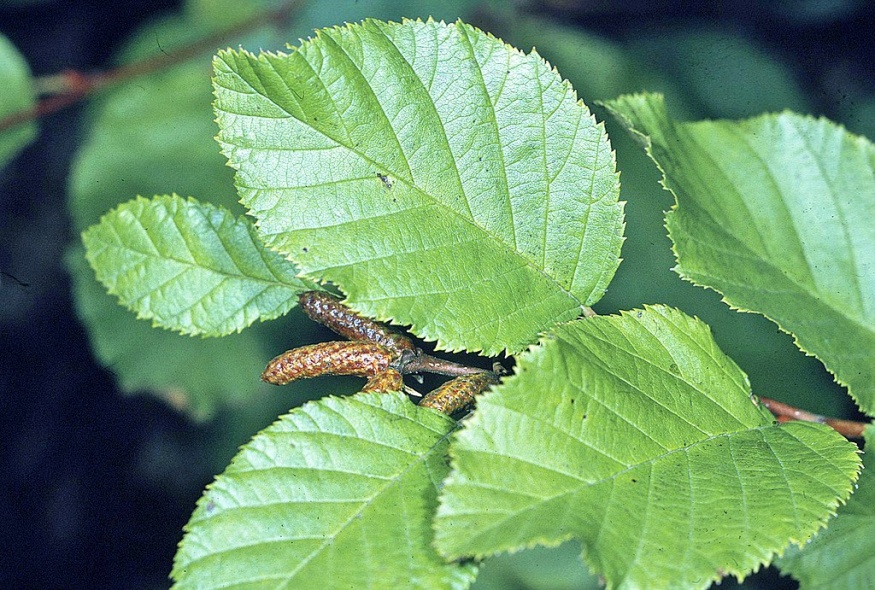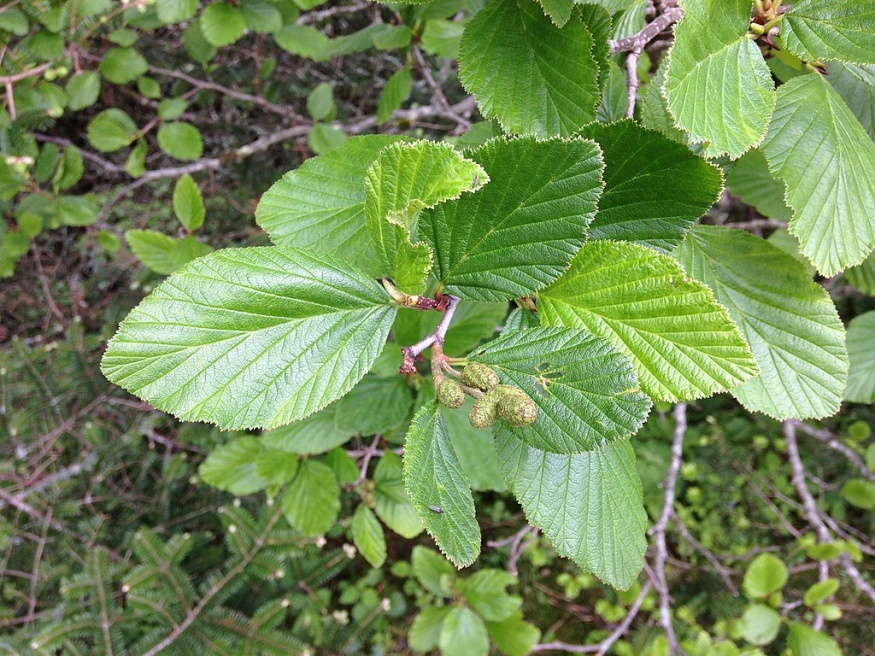About
Green alder is a large spreading shrub, often forming thickets and occurring across North America; widely distributed from Alaska to Greenland. It is a close relative to the stika alder (Alnus viridus ssp. sinuata) and together these species span the Northern Hemisphere. Green alder is a short-lived 'nurse tree' or pioneer species following glacial retreat, landslides, or man made disturbances. Interestingly, it has a symbiotic relationship with microorganisms that can fix nitrogen from the air.
Leaves are shinny, yellowish green, ovate or broadly elliptic; finely toothed and possibly undulated. Smooth, dark reddish brown twigs are covered with light lenticels. Male and female flowers occur on the same tree and appear from April to May. Like other alders, the fruit is cone-like, starting yellow then turning brown.
The bark has been use medicinally by natives as an astringent, or for tanning leather and dying textiles. Green alder is ecologically valuable as a soil stabilizer for streambanks, as a windbreak, and to improve soil quality in nutrient poor sites.
References
Fire Effects Information System (FEIS). (n.d.). Alnus viridis subsp. crispa Retrieved from https://www.fs.fed.us/database/feis/plants/shrub/alnvirc/all.html
Lady Bird Johnson Wildflower Center. (2016). Alnus viridis. Retrieved from https://www.wildflower.org/plants/result.php?id_plant=alvi5
Oregon State University. (n.d.). Alnus viridis subsp. crispa. Retrieved from https://landscapeplants.oregonstate.edu/plants/alnus-viridis-subsp-crispa#:~:text=crispa,-Alnus%20viridis%20subsp&text=Broadleaf%2C%20deciduous%2C%20large%20spreading%20shrub,lenticels%20(appear%20as%20dots).
Plants For A Future. (2018). Alnus viridis crispa - (Aiton.)Turrill. Retrieved from https://pfaf.org/user/Plant.aspx?LatinName=Alnus+viridis+crispaLatinName=Salix+eriocephala
Tree Canada. (n.d.). Green alder (Alnus viridis ssp. crispa). Retrieved from https://treecanada.ca/resources/trees-of-canada/green-alder-alnus-viridis-ssp-crispa/
United States Department of Agriculture. (n.d.). Stika Alder. Retrieved from https://plants.usda.gov/plantguide/pdf/pg_alvis.pdf
Growing From Seed
Growing from seed is one of the most economical and satisfying ways to build a native plant garden. The table shows brief planting instructions, including how long and what kind of stratification this plant needs. For further information on stratification and seed preparation please refer to our article: Preparing To Grow Wild Plant Seeds
| Seeds/Packet | Coming soon... |
|---|---|
| Seeds/Gram | Coming soon... |
| Cost/Gram | $Price coming soon... |
| Dormancy Treatment | Cold Moist Stratification |
| Seeding Instructions | Cold moist stratify for 1 to 2 months. Spring plant in full sun to part shade, making sure to keep moist the entire time. |
Growing From Plants
Seedlings are a more economical option than established plants and an easier start than growing from seed. 4 pack plants indavidually have and approximate 2" square root ball. We also have large soil block plants, which are a bit more established than the seedlings. These grow as approximate 4" blocks. Plants do surprizingly well in the mail but need special care upon arrival. Please see Planting Mail Order Seedlings for information on how to plant and care for seedlings.
Shipping
We currently ship seeds to all Canadian provinces and ship plants just within the provinces of British Columbia and Alberta. Seeds ship year-round and usually take a few days (or longer if you are ordering from a distant province). It usually takes 2-5 business days in the mail for plant orders once shipped. Plants are generally available from May to September and can be reserved during off season; Shipping costs are calculated during checkout. Seed orders over $100 ship free! See Shipping for more details.

